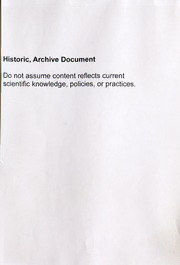
International Conference on Nutrition paper submitted by the United States of America PDF
Preview International Conference on Nutrition paper submitted by the United States of America
Historic, Archive Document Do not assume content reflects current scientific knowledge, policies, or practices. i I Reserve aTX360 .U6I57 1992 INTERNATIONAL CONFERENCE ON NUTRITION PAPER SUBMITTED BY THE UNITED STATES OF AMERICA Prepared by U.S. Department of Agriculture and U.S. Department of Health and Human Services April, 1992 I United States Department of Agriculture TABLE OF CONTENTS PAGE # I. The Nature and Dimension of Nutrition and Diet- Related Problems I-l A. Assessment of Nutritional Problems I-l B. Additional Analysis by Population Groups 1-7 II. Description and Analysis of Factors Affecting Nutritional Status of the Population II-l A. Macroeconomic Environment and Nutrition II-l B. Food Security II-5 C. Living Conditions, Health Status, Health and Social Services 11-17 D. Lifestyles and Behavior 11-20 III. Analysis of Current Policies, Programs, and Interventions Affecting Nutritional Status III-l A. Impact of Programs, Projects, and Policies Directed at Preventing Nutritional Problems and Improving Nutritional Status III-l B. Effects of Sectoral and Economic Policies on Nutrition III-6 C. Human, Technical, and Financial Resources Directed Towards Preventing Nutritional Problems and Improving Nutritional Status III-8 IV. Recommendations for Future Actions IV-1 A. Goals or Reasonable Aims IV-1 B. Action and Strategies Needed for Implementation IV-6 C. Financial and Human Resources/Constraints IV-15 * .,.1 APPENDICES Executive Summary: Nutrition Monitoring in the United States I-l Average Micronutrient Intake for Various Age-Sex Groups 1-2 Description of Federal Food Assistance Programs II-l Age and Sex Specific Recommended Dietary Allowances (RDAs) II-2 . . . Per-capita Food Availability II-3 Federal Research Activities III-l Additional Food and Nutrition Objectives from Healthv People 2000 IV-1 Nutrition Monitoring Objectives from: Nutrition Monitoring in the United States; An Update Report on Nutrition Monitoring IV-2 Recommendations from: Improving America s Diet and ' Health: From Recommendations to Action IV-3 National Nutrition Monitoring and Related Research Act and the Draft 10-Year Plan for Nutrition Monitoring in the United States IV-4 Executive Summary Overall, the profile of nutrition in the U.S. is very good by international standards. The U.S. has an abundant food supply and is a major exporter of agricultural products. Chronic dietary energy deficiency and protein-energy malnutrition are extremely rare. Diseases of nutritional deficiency (i.e., rickets, pellagra, scurvy) are virtually nonexistent. U.S. con—sumers spend about 12 percent of their disposable income on food a small amount by international standards. The share of income spent on food dropped by about 15 percent from 1970 to 1990. The U.S. has extensive food assistance programs available for those in need. In Fiscal Year 1991, the U.S. spent over $28 billion for domestic food and nutrition assistance. Despite this generally positive situation, there remain serious nutritional challenges for the United States to overcome. As the diseases of nutritional deficiency have diminished, they have been replaced by diseases related to dietary excess and — imbalance problems that now rank among the leading causes of illness and death in the United States, touch the lives of most Americans, and generate substantial health care costs. Obesity is a significant health problem. Approximately one-fourth of adults are overweight and, among certain population groups, rates of overweight are even higher. Four of the ten leading cases of — death in the United States are associated with diet coronary hearth disease, some types of cancer, stroke, and non-insulin dependent diabetes. Certain population groups are at greater risk for nutritional problems. For example, children in poverty are more likely to experience iron deficiency and growth retardation. The paper looks at the magnitude of these diseases and conditions, changes over time, and differential distribution among population groups for whom data are available. The paper also contains a summary of a wide range of nutrition- related recommendations, in such areas as nutrition education, food security, food safety, nutrition monitoring, and research. These recommendations draw upon a wide range of previously published reports and studies from various sources. National policy objectives for nutrition are embodied in the Dietary Guidelines for Americans Nutrition is also a key focus of . Healthy People 2000 the health objectives for the United States . for the Year 2000. In addition to diet-related objectives to improve health status and reduce chronic disease risk Healthy , People 2000 includes emphasis on objectives for nutrition education in schools and to students in the health care professions. In 1989, the U.S. Departments of Agriculture and Health and Human Services jointly released Nutrition Monitoring in the United States; An Update Report on Nutrition Monitoring This report . reviews the dietary and nutritional status of the U.S. population based on data available through the Departments nutrition ' monitoring activities. The recently published report of the National Academy of Science entitled Improving America's Diet and Health; From Recommendations to Action details steps which could be taken by the public and , private sectors and health care professionals as well as strategies for education of the public and directions for research. Numerous other public and private organizations are also working toward achieving health and nutrition objectives. The paper discusses a number of strategies for reaching future nutrition-related goals, including: the promotion of healthy lifestyles; enhancing "caring capacity" within the household and within society; improving household food security; developing food safety initiatives; assessing, analyzing, and monitoring nutrition situations; and prioritizing research activities. Since the content and focus of the U.S. Country Paper were dictated by the needs of the conference organizers, the paper should not be viewed as a comprehensive statement of official U.S. Government policy.
